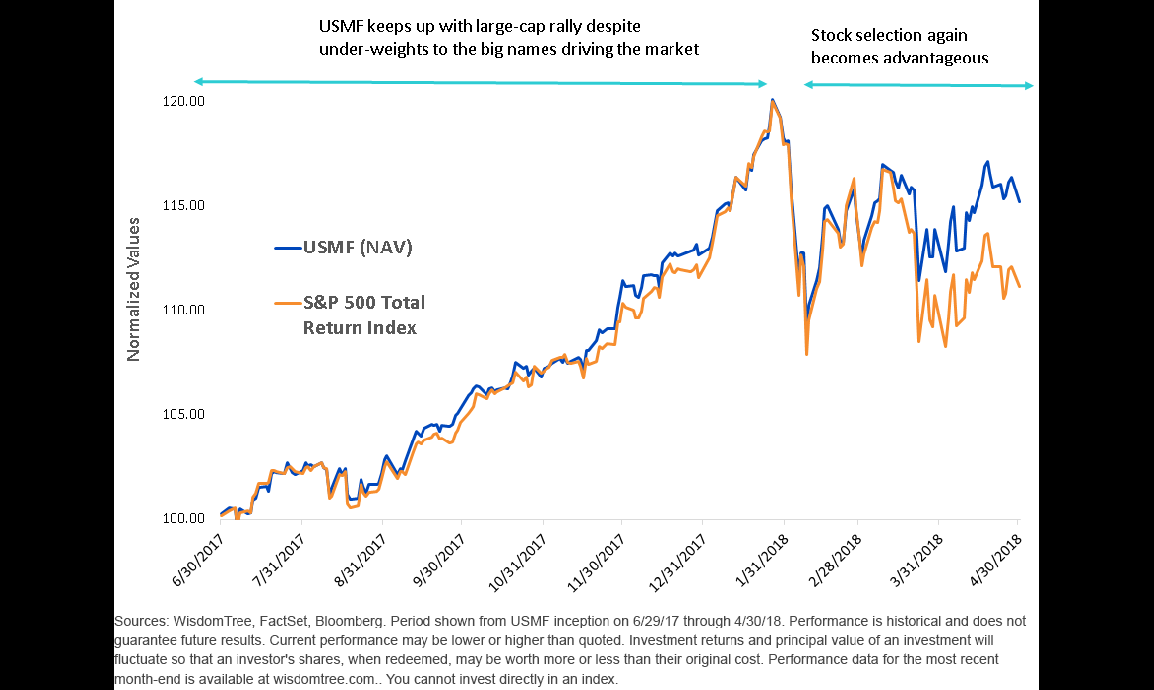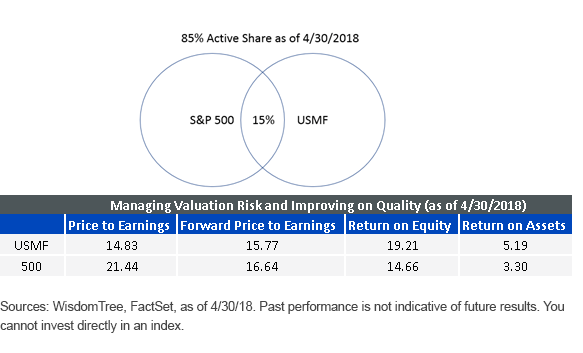WisdomTree U.S. Multifactor Stock Selection is Back


When we launched the WisdomTree U.S. Multifactor Fund (USMF) on June 29, 2017, it was difficult for stock pickers to add value. From that point until January 26 of this year, some of the largest names in the S&P 500 Index, such as Microsoft, Amazon and Netflix, were decimating broader averages with respective returns of 39%, 44% and 83%, making a simple market cap-weighted approach hard to beat.
For example, the passive WisdomTree U.S. Multifactor Fund, which selects 200 stocks based on exposure to value, quality, momentum and low correlation, had 0% exposure to all three of the above-mentioned market generals during this large-cap bull-run period. (For current holdings of USMF, click here.
Despite this strong headwind, the chart below shows how, since inception until the end of the unrestricted bull run, USMF kept pace with the S&P 500. Then, from January 26 to April 30 (the time of this writing), volatility re-entered the market, allowing USMF’s methodology to kick it into the next gear. Over this volatile period, USMF added more than 300 basis points (bps) of excess total return versus the S&P 500.
For standardized performance of USMF, click here.
USMF vs. S&P 500 Total Return, 6/29/17–4/30/18

USMF’s Key to Success: Intelligent Active Share
Active share measures how “alike” a strategy is to its benchmark based on the stocks selected and the weights assigned to them. Thus, 0% active share means stocks and weights are identical, while 100% active share means there is nothing in common between a strategy and its benchmark.
It was USMF’s high active share and effective stock selection that not only allowed it to keep pace with the S&P 500 as it rose, but also outperform when it turned.

For definitions of terms in the chart, please visit our glossary.
A fund with low active share would have inevitably followed the S&P 500 downward since January 26, just as it rose with the S&P 500 earlier. Lower active share would also limit the ability for important fundamentals to deviate meaningfully from the benchmark. As shown above, USMF’s high active share allows fundamentals critical to managing valuation risk and improving on quality to diverge meaningfully from the S&P 500. This difference in behavior is what makes USMF different.
WisdomTree believes that, at its core, factor investing is meant to aggressively seek alpha, but only in a well-informed manner. That is why we conducted years of research and use four academically vetted factors. It’s why we weight not only by half of a stock’s multifactor exposure, but also by half its inverse volatility. That is also why our approach is sector neutral to the market, allowing our factor-based stock selection to function on its own merit, without the benefit or harm of large sector bets versus the market.
Conclusion
To be clear, higher active share certainly comes with risks. It can result in higher tracking error and underperformance versus a benchmark, which may be hard for short-term investors to stomach. But it’s also important to remember that, without active share and tracking error, excess return is impossible. The question then becomes, how much active risk do you want and how do you want to access it? In this regard, we think a sophisticated and passive multifactor approach at 28 bps can make a great deal of sense.
Important Risks Related to this Article
There are risks associated with investing, including possible loss of principal. Investing in a Fund exposed to particular sectors increases vulnerability to any single economic, political or regulatory development. This may result in greater share price volatility. Due to the investment strategy of the Fund, it may make higher capital gain distributions than other ETFs. Please read the Fund’s prospectus for specific details regarding the Fund’s risk profile.

